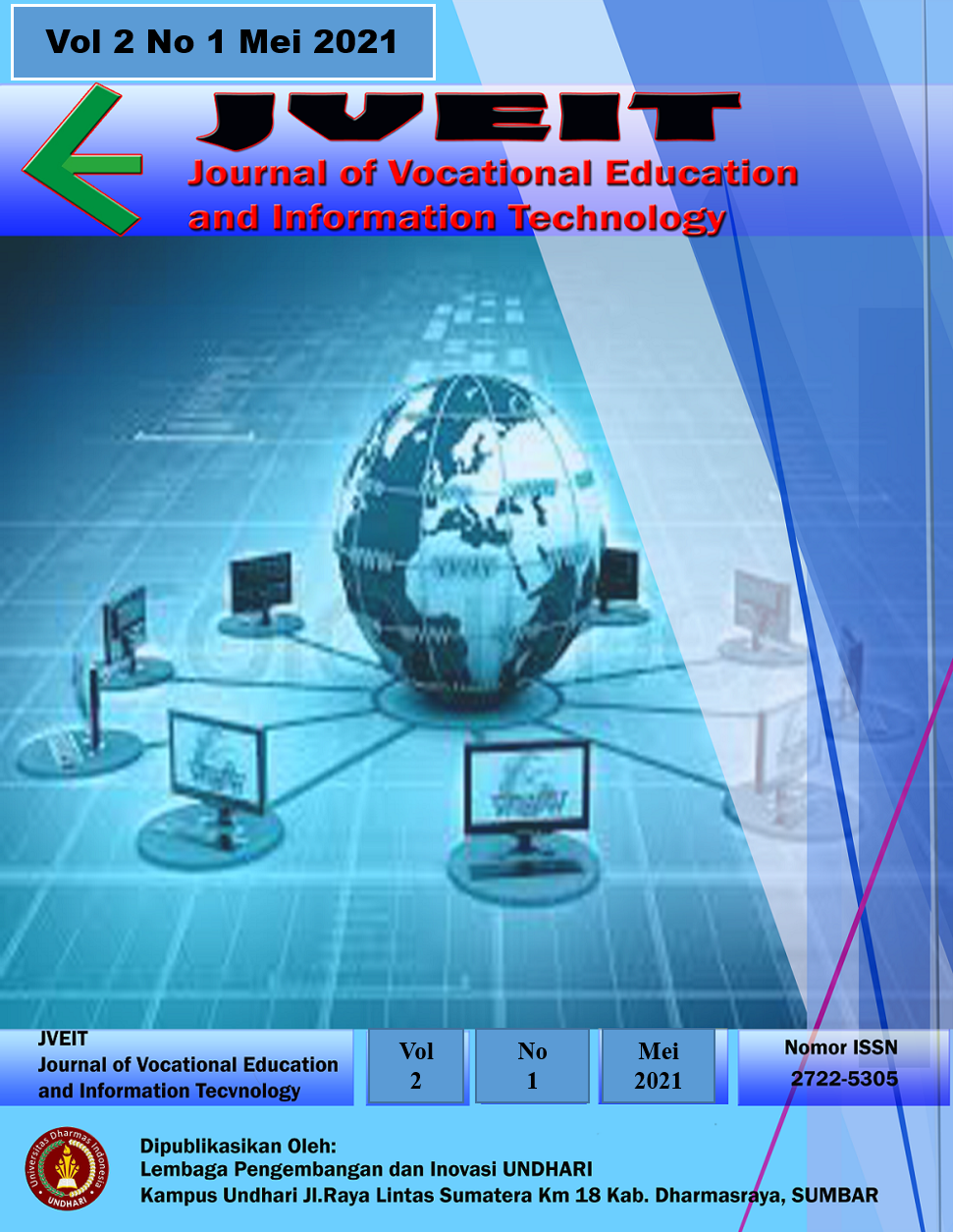Mathematical Problem Solving Ability: Comparison of Guided Discovery Learning Model and Problem Based Learning Model
Kemampuan Pemecahan Masalah Matematis: Perbandingan Model Guided Discovery Learning dan Model Problem Based Learning
DOI:
https://doi.org/10.56667/jveit.v2i1.93Keywords:
Mathematical Problem Solving Ability, Guided Discovery Learning Model, Problem Based Learning Model, Quantitative, QualitativeAbstract
The purpose of this study was to examine the achievement of mathematical problems solving ability between students who acquired learning with Problem Based Learning model with students who acquired learning with Guided Discovery Learning model. This research was a mixed method research with concurrent embedded method. This research consists of experimental group that obtained learning with Guided Discovery Learning method and Problem Based Learning method. The population of this research was a junior high school students in Tanah Datar regency, West Sumatera with sample of grade VIII. Data analysis was done quantitatively and qualitatively. Quantitative analysis was used to calculate the difference in the achievement of mathematical problem solving ability, while qualitative data analysis was used to strengthen the result of quantitative analysis. The results showed that the percentage of the achievement of mathematical problem solving ability of students who obtained learning with Guided Discovery Learning method and Problem Based Learning method is moderate, whereas there is no difference in the achievement of significant mathematical problem solving ability between the two experimental classes.
Downloads
References
[2] Luzviminda, dkk., 2015. The Effect of Group Guided Discovery Approach on the Performance of Students in Geometry.International Journal of Multidiciplinary Research and Modern Education (IJMRME), ISSN (online) : 2454-6119
[3] Suherman, E., 2003. Evaluasi Pengajaran Matematika. Bandung: UPI.
[4] Hoosain, E., 2001. What Are Mathemathical Problems. Augusta: Augusta State University.
[5] Effendi, L.A., 2012. Pembelajaran Matematika dengan Metode Penemuan Terbimbing untuk Meningkatkan Kemampuan Representasi dan Pemecahan Masalah Matematis Siswa SMP. Jurnal Pendidikan Matematika, Vol. 13, No. 2 Oktober 2012.
[6] Nahil, M., 2015. University Student’s Learning Styles and Their Ability to Solve Mathematical Problems. International Journal of Business and Social Science, Vol. 6, No. 4(1); April 2015
[7] Ranjan, dkk., 2013. Math Anxiety: The Poor Problem Solving Factor in School Mathematics. International Journal of Scientific and Research Publications, Volume 3, Issue 4, April 2013, ISSN 2250-3153.
[8] Rahman, Md. Mehadi, 2019. 21st Century Skill “Problem Solving”: Defining the Concept. Asian Journal of Interdisiplinary Research, Vol. 2, Issue 1.
[9] Prabawanto, S. 2013. Menignkatkan Kemampuan Pemecahan Masalah, Komunikasi, dan Self-Effacy Matematis Mahasiswa melalui Pembelajaran dengan Pendekatan Metacogniteve Scaffolding. S-3. Bandung: Universitas Pendidikan Indonesia.
[10]Rofiqoh, Z., Rochmad, R., & Kurniasih, A., 2016. Analisis Kemampuan Pemecahan Masalah Matematika Siswa Kelas X Dalam Pembelajaran Discovery Learning Berdasarkan Gaya Belajar Siswa. Unnes Journal of Mathematics Education, 5(1). https://doi.org/10.15294/ujme.v5i1.9344
[11]Rahayuningsih, 2014. Analisis Kesalahan Menyelesaikan Soal Cerita SPLDV dan Scaffoldingnya berdasarkan Analisis Kesalahan Newman pada Siswa Kelompok VIII SMP Negeri 2 Malang. Jurnal Pendidikan Matematika dan Sains Tahun II, No.1, Juni 2014.
[12]Jarmila, dkk., 2014. Problem Solving in School Mathematics Based on Heuristic Strategies.Journal on Efficiency and Responsibility in Education and Science, Vol. 7, No. 1, Hal. 1-6, online ISSN 1803-1617, printed ISSN 2336-2375,DOI: 10.7160/eriesj.2013.070101.
[13]Mulyani, A., 2016. Perbedaan Kemampuan Pemecahan Masalah Matematis Siswa Menggunakan Pembelajaran Model M-Apos Melalui Siklus ACE dengan Pembelajaran Konvensional. Artikel UPI [online] Tersedia di: http://docplayer.info/54538135-Perbedaan-kemampuan-pemecahan-masalah-matematis-siswa-menggunakan-pembelajaran-model-m-apos-melalui-siklus-ace-dengan-pembelajaran-konvensional.html.
[Accessed 20 September 2020]
[14]Nurcahyo, N.. 2014. Pendekatan Problem Posing Untuk Meningkatkan Kemampuan Pemecahan Masalahdan Pengajuan Masalah Matematis Serta Habits Of Mind Siswa SMA. S-2. Bandung: Universitas Pendidikan Indonesia.
[15]Yulianti, Novi. 2015. Penerapan Metode Pembelajaran Student Facilitator and Explaining dalam Meningkatkan Kemampuan Pemecahan Masalah Matematis Siswa. E-Journal UPM. Vol. 1. No. 2.
[16]Rahmat, A, Caswita, dan Bharata, H. 2015. Efektivitas Penggunaan Model Guided Discovery Learning Ditinjau dari Pemecahan Masalah Matematis Siswa. Jurnal Pendidikan Matematika UNILA. Vol 3. No. 6
[17]Nugraheni, F, Mastur, Z, dan Wijayanti. 2014. Keefektifan Model Process Oriented Guided Inquiry Learning terhadap Kemampuan Pemecahan Masalah. Unnes Journal of Mathematics Education. Vol 3. No. 1. Hlm. 1-7
[18]Ariyani, D, F, Wuryanto, Prabowo, A. 2013. Keefektifan Model MMP pada Kemampuan Pemecahan Masalah disertai Identifikasi tahap Berpikir Geometri. Unnes Journal of Mathematics Education.Vol. 2, No 1. Hlm. 1-7
[19]Junaedi, I, dkk. 2012. Keefektifan Implementasi Model Pembelajaran Problem Posing dan Kreatif Problem Solving terhadap Kemampuan Pemecahan Masalah Peserta Didik di SMPN 1 Tenggara. Unnes Journal of Mathematics Education. Vol.1. No. 2. Hlm. 1-7
[20]Sutama, Mayasari A. 2016. Hasil Belajar Matematika dengan Strategi Discovery Learning dan Group Investigation ditinsutajau dari Keaktifan Siswa SMP. Varia Pendidikan. Vol. 28. No. 1. Juni 2016: 1-10.
[21]Widjajanti, D. B. 2011. Mengembangkan Softskill Siswa melalui Pembelajaran Matematika Berbasis Masalah. Di: Seminar Nasional Pendidikan MIPA 2011, Pengembangan Pembelajaran MIPA Berorientasi Soft Skill. Bandar Lampung, Indonesia, 26 November 2011. PMIPA FKIP UNILA: Bandar Lampung.
[22]Sariningsih, Ratna. 2017. Pembelajaran Problem Based Learning untuk Meningkatkan Kemampuan Pemecahan Masalah Matematis dan Self-efficacy Mahasiswa Calon Guru. JNPM (Jurnal Nasional Pendidikan Matematika) . Vol. 1. No.1. hlm 163.
[23]Lestari, Fuji. Dkk., 2015. Efektivitas Model Problem Based Learning Ditinjau Dari Kemampuan Pemecahan Masalah Matematis Siswa. Jurnal Pendidikan Matematika Universitas Lampung, Vol. 3, No.1.
[24]Nur, M. 2011. Model Pembelajaran Berdasarkan Masalah. Pusat Sains dan Matematika Sekolah UNESA.
[25]Sugiyono. 2016. Model Penelitian Kuantitatif Kualitatif dan Kombinasi (Mixed Methods). Bandung : Alfabeta.
[26]Trianto. 2007. Model Pembelajaran Terpadu dalam Teori dan Praktek. Jakarta: Prestasi Pustaka.
[27]Arends, R. 2009. Learning to Teach Seventh Edition. McGraw Hill Comapanies, Inc, 1221 Avenue of the American, New York, NY 10020.
[28]Sukmana, P. B. 2009. Model Pembelajaran Guided Discovery (Penemuan Terbimbing). [Online] Tersedia di : https://prasetyabudisukmana.wordpress.com/2009/07/22/model-pembelajaran-guided-discovery-pennemuan-terbimbing/. [Accessed 25 September 2020]









